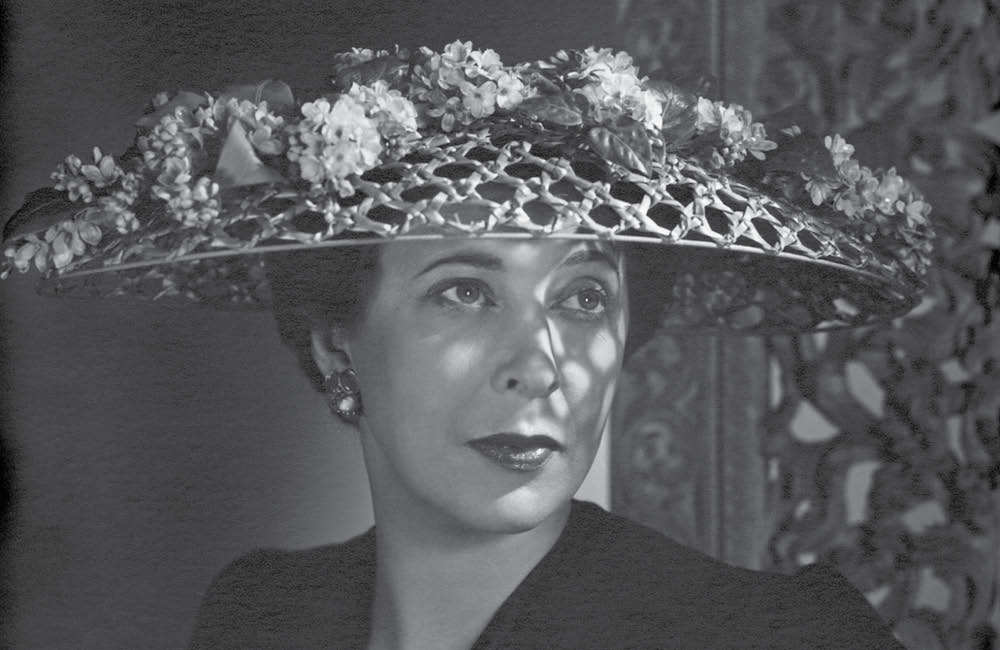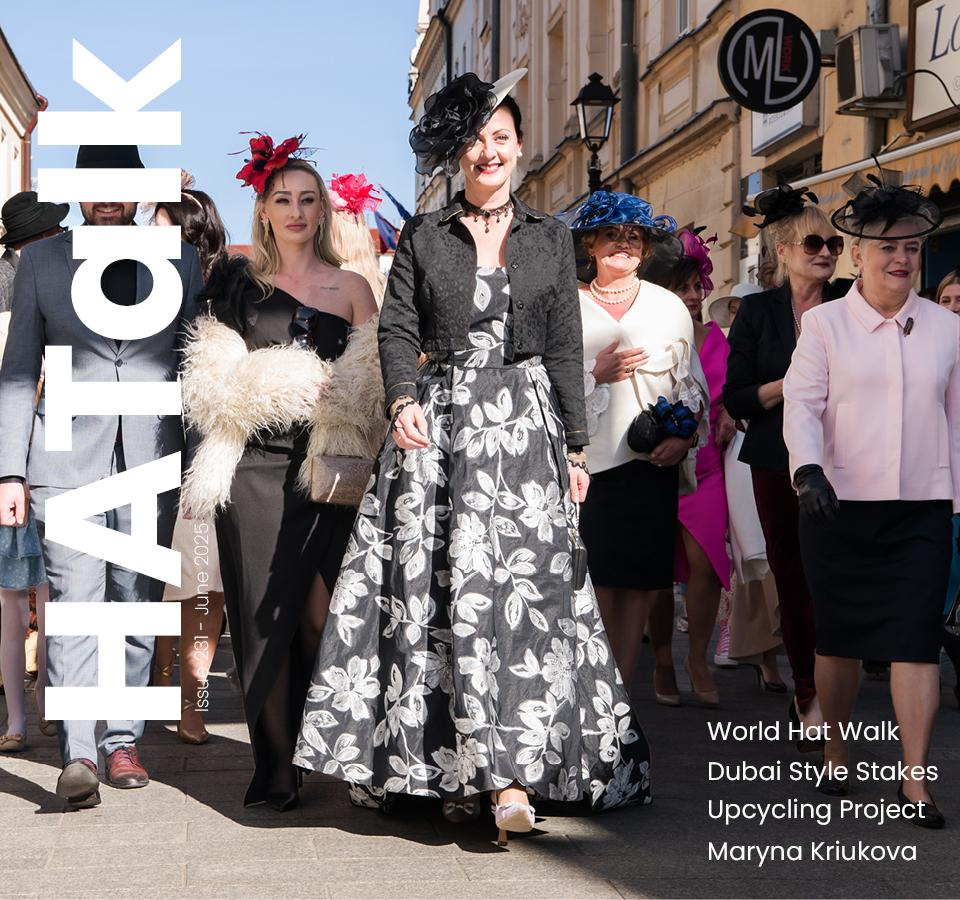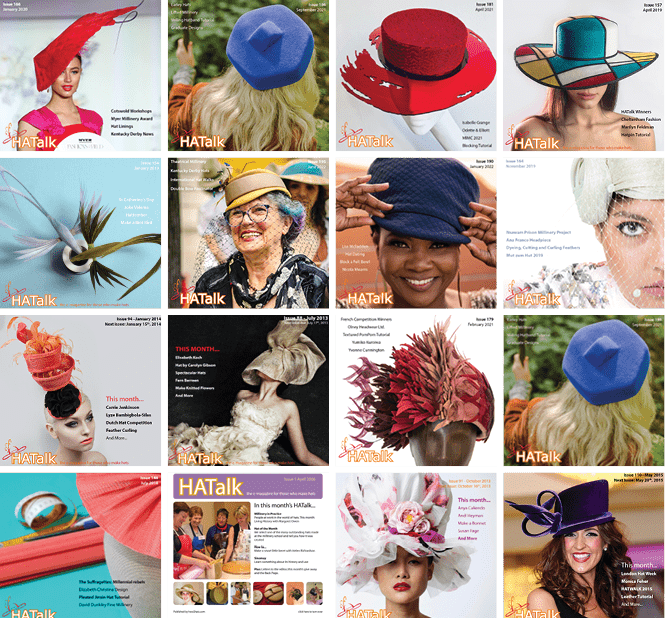Blog / Shopping for Secondhand Millinery Supplies
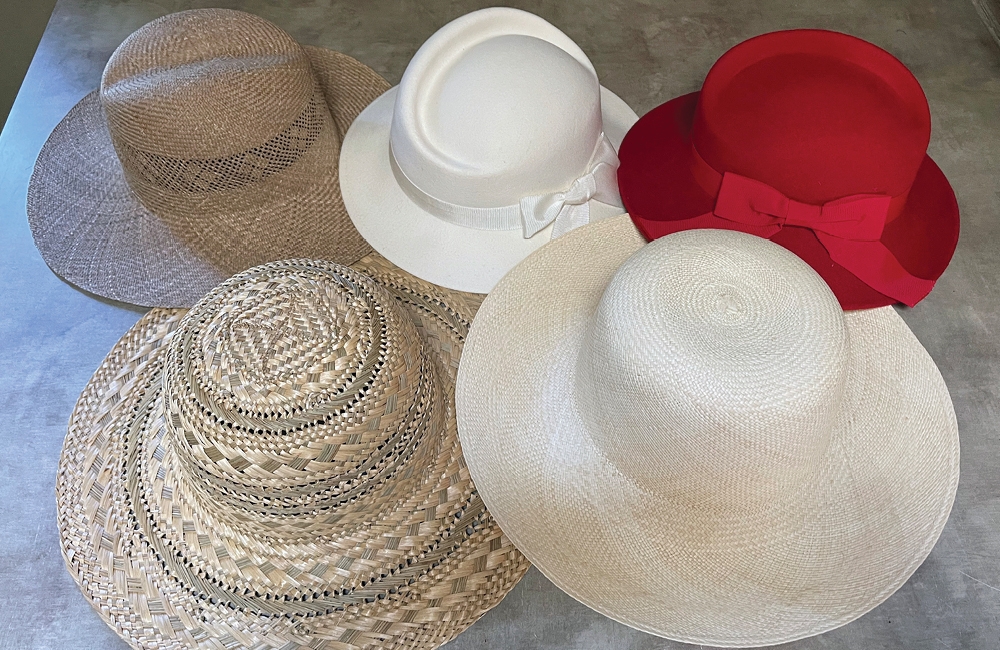
Shopping for Secondhand Millinery Supplies
Treasure Hunting for Millinery Materials
It is both economical and environmentally sustainable to reuse and repurpose materials. Garage and estate sales (or car boot sales in the UK) are great local, inexpensive opportunities to source millinery materials. Flea markets, brocantes and secondhand thrift shops can also be fun places to go millinery treasure hunting; you never know what you will find!
Here are some specific materials to be on the lookout for…
Feathers
Since large peacock feathers are often used in home décor, they are usually the easiest to find. These can often be purchased at a fraction of the normal retail price. There may also be crafters, hunters, farmers, fishermen or performers out there getting rid of a variety of feathers.
Fabrics
Don’t just look for craft fabric – keep an eye out for clothing made out of interesting fabrics as well. You can often find unique patterned silk and satins, wools, and other materials. Generally, these will be women’s garments but scarves or men’s ties are also great finds. These narrow fabrics can make lovely hatbands.
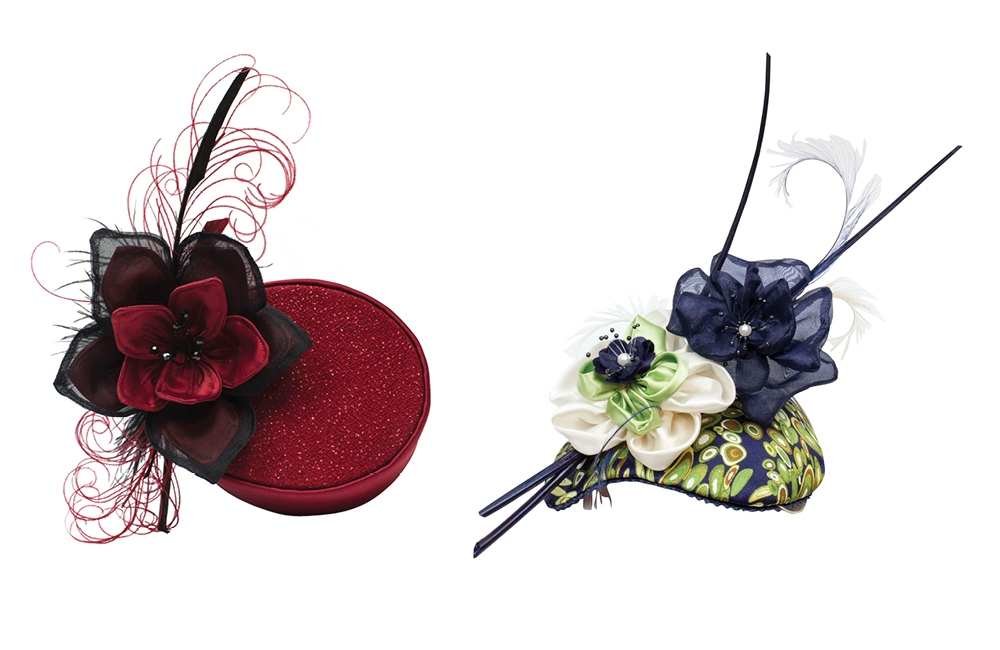
These are a couple pieces that I made with repurposed clothing. The red pillbox was covered with a red sparkly fabric cut out of a child’s dress. The fascinator was covered with a piece of pattern satin from a women’s top.
Hats
Of course, you always want to be on the lookout for any ready-to-wear vintage or commercial hats. Even if they are not wearable, they can be a great source of secondhand millinery supplies.
There are many possibilities for repurposing a vintage hat. You can often find high-quality wool and fur felts and straws that, with a little work, can be reblocked into a whole new hat. Old cello and stitched straw hats can be unwoven so that you can reuse the braid. Look for interesting trims; even a hat in poor condition can be disassembled for quality trims. Vintage feathers and flowers are great to use and can be expensive to buy online.
First, check for a designer label and look at the condition. If it was made by a well-known designer, you may want to restore it. Then you can wear it, resell it or, if you like the styling, just keep it for inspiration.
Next check the condition of the hat, looking for stains, smells or damage. This will help you figure out the best way to salvage the hat. Check how the trims are attached. Was so much glue used that it would be impossible to rescue the base of the hat? Would the trimmings be ruined if you removed them? Or was the hat sewn together, making it easy to remove ribbons, bands, and trims? If damage from removing items is localized, you can often still reuse the hat. Just block to where the damage will be hidden with trimming.
Don’t miss out on modern and commercial hat finds either. The hat pictured below was made from a lovely fine straw that had an open pattern around the crown. It has been decorated with a silk scarf for a hatband.
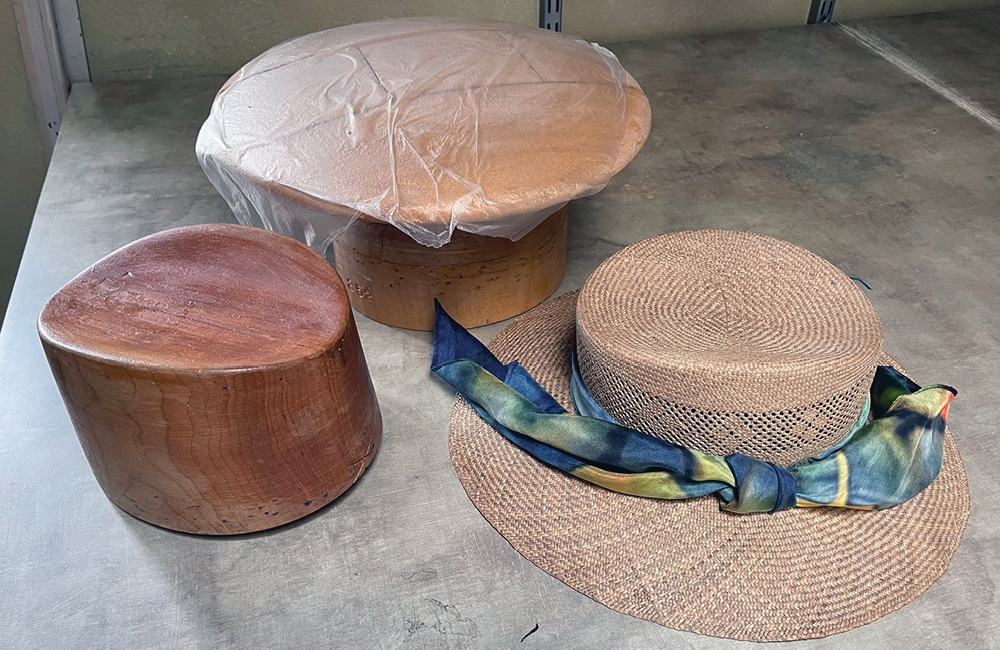
You can often find sun hat styles that are basically unblocked straw capelines. Sometimes you can find very nice quality straw with really interesting patterns this way. Also, look for floppy ‘hippy’ style felt hats. These are basically unblocked felt capelines and, although they might not be made from high-quality wool felt, they can be reblocked as hat foundations and covered with fabric or leather.
Where to Look
You should be able to find details of local sales online, on Facebook or other listing websites, and don’t forget your local second-hand stores. If you start to attend estate sales and auctions hosted by a specific company, it might be worth getting to know the business owner. Give them your contact information and tell them that you are interested in hats – that way you’ll be the first to hear about relevant sales and may even score early access. Of course, you might not always find a millinery treasure as you trawl through someone else’s ‘trash,’ but, at the very least, exploring local garage sales will get you outside and chatting with your neighbors.
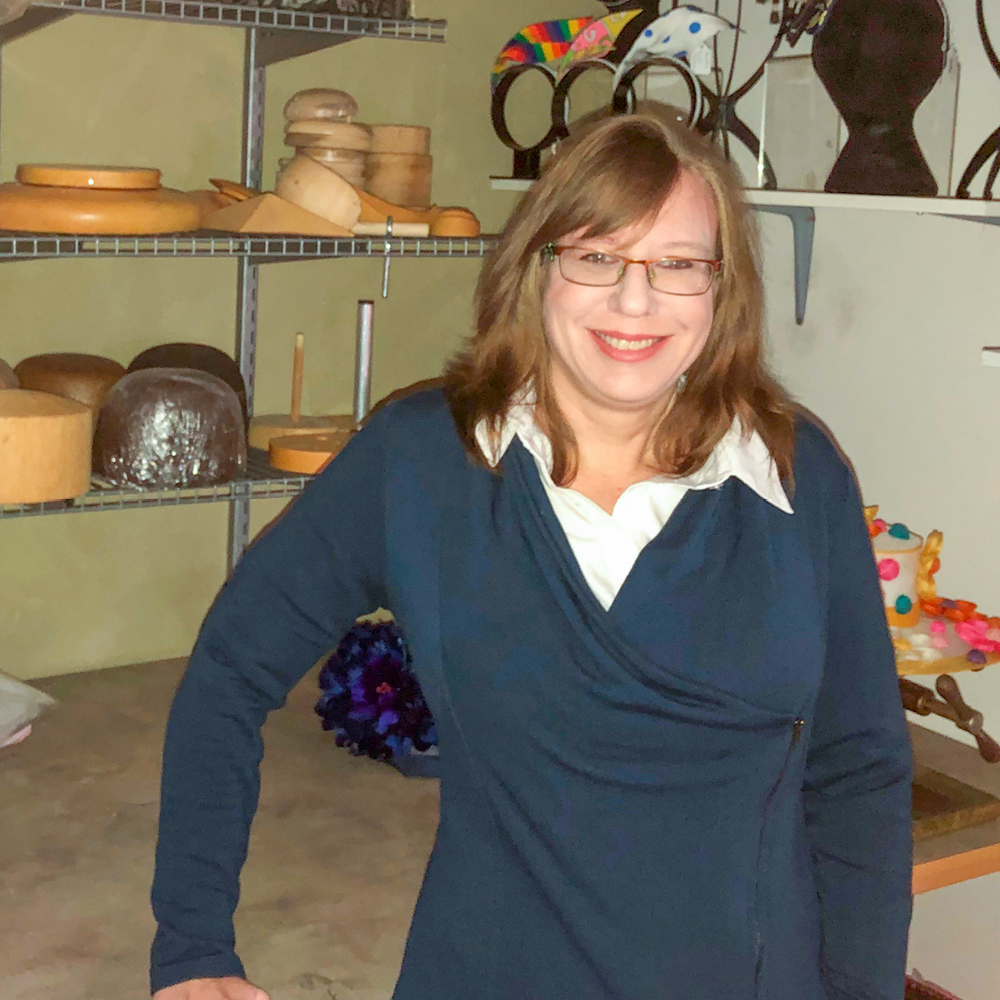
About the Author
Amy Fowler is the creator of the bespoke, California-based Millinery by Amy Fowler label. She also runs Humboldt Haberdashery, an online millinery supplier.
See Amy’s full bio HERE.
Popular Articles
Latest e-Magazine
Featured Supplier

Shopping for Secondhand Millinery Supplies
Treasure Hunting for Millinery Materials
It is both economical and environmentally sustainable to reuse and repurpose materials. Garage and estate sales (or car boot sales in the UK) are great local, inexpensive opportunities to source millinery materials. Flea markets, brocantes and secondhand thrift shops can also be fun places to go millinery treasure hunting; you never know what you will find!
Here are some specific materials to be on the lookout for…
Feathers
Since large peacock feathers are often used in home décor, they are usually the easiest to find. These can often be purchased at a fraction of the normal retail price. There may also be crafters, hunters, farmers, fishermen or performers out there getting rid of a variety of feathers.
Fabrics
Don’t just look for craft fabric – keep an eye out for clothing made out of interesting fabrics as well. You can often find unique patterned silk and satins, wools, and other materials. Generally, these will be women’s garments but scarves or men’s ties are also great finds. These narrow fabrics can make lovely hatbands.

These are a couple pieces that I made with repurposed clothing. The red pillbox was covered with a red sparkly fabric cut out of a child’s dress. The fascinator was covered with a piece of pattern satin from a women’s top.
Hats
Of course, you always want to be on the lookout for any ready-to-wear vintage or commercial hats. Even if they are not wearable, they can be a great source of secondhand millinery supplies.
There are many possibilities for repurposing a vintage hat. You can often find high-quality wool and fur felts and straws that, with a little work, can be reblocked into a whole new hat. Old cello and stitched straw hats can be unwoven so that you can reuse the braid. Look for interesting trims; even a hat in poor condition can be disassembled for quality trims. Vintage feathers and flowers are great to use and can be expensive to buy online.
First, check for a designer label and look at the condition. If it was made by a well-known designer, you may want to restore it. Then you can wear it, resell it or, if you like the styling, just keep it for inspiration.
Next check the condition of the hat, looking for stains, smells or damage. This will help you figure out the best way to salvage the hat. Check how the trims are attached. Was so much glue used that it would be impossible to rescue the base of the hat? Would the trimmings be ruined if you removed them? Or was the hat sewn together, making it easy to remove ribbons, bands, and trims? If damage from removing items is localized, you can often still reuse the hat. Just block to where the damage will be hidden with trimming.
Don’t miss out on modern and commercial hat finds either. The hat pictured below was made from a lovely fine straw that had an open pattern around the crown. It has been decorated with a silk scarf for a hatband.

You can often find sun hat styles that are basically unblocked straw capelines. Sometimes you can find very nice quality straw with really interesting patterns this way. Also, look for floppy ‘hippy’ style felt hats. These are basically unblocked felt capelines and, although they might not be made from high-quality wool felt, they can be reblocked as hat foundations and covered with fabric or leather.
Where to Look
You should be able to find details of local sales online, on Facebook or other listing websites, and don’t forget your local second-hand stores. If you start to attend estate sales and auctions hosted by a specific company, it might be worth getting to know the business owner. Give them your contact information and tell them that you are interested in hats – that way you’ll be the first to hear about relevant sales and may even score early access. Of course, you might not always find a millinery treasure as you trawl through someone else’s ‘trash,’ but, at the very least, exploring local garage sales will get you outside and chatting with your neighbors.

About the Author
Amy Fowler is the creator of the bespoke, California-based Millinery by Amy Fowler label. She also runs Humboldt Haberdashery, an online millinery supplier.
See Amy’s full bio HERE.
